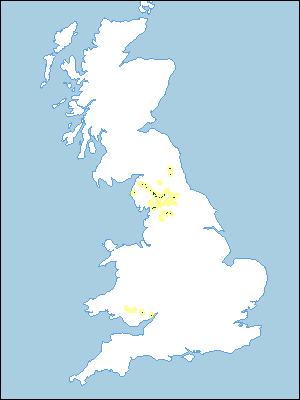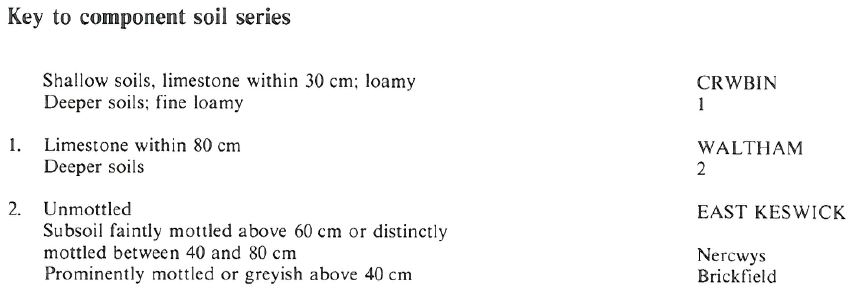
Soil Associations
0541q WALTHAM
Soil and site characteristics
Well drained fine loamy soils over limestone, locally deep. Shallow loamy soils in places. Bare rock locally.
Geology
Drift over Carboniferous limestone
Cropping and Land Use
Permanent grassland with stock rearing in Cumbria; some cereals in drier districts.
Component soil series
| Subgroup | Series name | Percentage | WRB 2006 link |
|---|---|---|---|
| 5.41 | WALTHAM | 41% | Eutric Endoleptic Cambisols |
| 5.41 | EAST KESWICK | 39% | Eutric Cambisols |
| 3.13 | CRWBIN | 10% | Eutric Leptosols |
Covers 239 km2 in England and Wales
Soilscapes Classification
| 7 |
Freely draining slightly acid but base-rich soils |
0541q WALTHAM
Detailed Description
This association, extending nationally to 245 km², is composed of soils in non-calcareous drift over Carboniferous Limestone, generally between 170 and 490 m O.D. It is found mainly in Cumbria but also in North Yorkshire, Northumberland, Lancashire and Gwent. The principal soils are the well drained Waltham series, fine loamy typical brown earths, with limestone within 80 cm of the ground surface; the East Keswick series, typical brown earths in deeper drift; and the Crwbin series, brown rankers in shallow drift over limestone.
The association covers some 7 km² in Gwent, mid-Glamorgan and Powys. There is no bare rock but there are shallow soils of the Crwbin and Elmton series on knolls. The mild climate in lowland Gwent favours agriculture, with a moisture deficit of around 100 mm, and an average annual rainfall of about 1,000 mm. The land is used mainly for ley grassland but there is some arable and also permanent grassland. Near Merthyr Tydfil in mid-Glamorgan where the climate is cooler and wetter, most of the association is under permanent grass. The main soils are permeable and well drained (Wetness Class I), and they readily absorb excess winter rainwater.
The association covers 218 km² and is mainly found near Shap, Orton, Kirkby Stephen, Kirkby Lonsdale and other places on the fringe of the Lake District. It also occurs near Richmond, in Swaledale, Wensleydale, Ribblesdale, Wharfedale and, to a very small extent, Corbridge. Distribution of the soils is generally simple and most often related to the thickness of the drift over limestone. Many East Keswick profiles show slight mottling and dull colours at depth and merge with Nercwys or, more rarely, Brickfield soils which are found where the drift is thicker and downward water-movement impeded. In places limestone bedrock is exposed, creating a distinctive landscape in which Crwbin soils occur. Deeper, reddish Newbiggin soils are found occasionally. As a result of leaching in the moist climate, calcareous horizons are rare.
Soil Water Regime
The main soils are permeable and well drained (Wetness Class I), and they readily absorb excess winter rainwater.
Cropping and Land Use
East Keswick soils have enough available water for most crops but the Waltham series, being shallower, can be slightly droughty. The main limitation to the use of these soils is the climate, with an annual rainfall often between 1300 and 1500 mm in the west. Although the soils are easily worked there are not normally enough days for much cultivation in either autumn or spring, and livestock production with a little dairying, based on permanent grass, is the principal land use. There is moderate poaching risk, severe in the wettest places, but good yields of grass are normally possible. The land dries quickly after wet weather and is particularly useful in districts characterized generally by less permeable, wetter soils.
0541q WALTHAM
Distribution Map
 |
Note that the yellow shading represents a buffer to highlight the location of very small areas of the association.
Keys to component soil series
Northern Region
 |
All information Copyright, Cranfield University © 2025
Citation: To use information from this web resource in your work, please cite this as follows:
Cranfield University 2025. The Soils Guide. Available: www.landis.org.uk. Cranfield University, UK. Last accessed 25/04/2025
